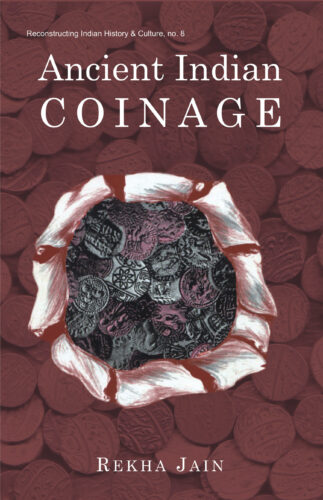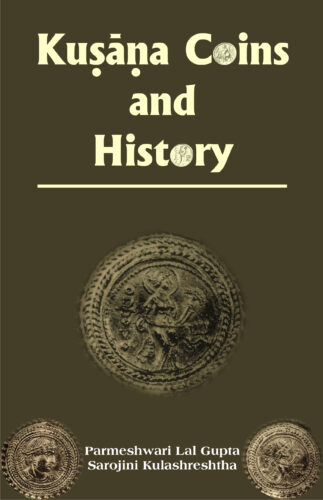

Ancient Indian Coina...
Ancient Indian Coinage (PB)
A Systematic Study of Money Economy from Janapada Period to Early Medieval Period (600 bc to ad 1200) by: Rekha JainThis book studies ancient Indias monetary economy in terms of its coinage through six successive periods from the janapadas to the pre-medieval. It establish linkages between the ancient coins and their references in ancient texts.
Original price was: ₹600.00.₹540.00Current price is: ₹540.00.
ISBN: 9788124600528
Year Of Publication: 1995
Edition: 1st
Pages : xv, 247 [+8]
Bibliographic Details : 50 Figures of coins; Bibliography; Index
Language : English
Binding : Paperback
Publisher: D.K. Printworld Pvt. Ltd.
Size: 23 cm.
Weight: 500
Money is unmistakably a landmark invention considering its indispensable role in economics and, more specially, in the commercial sphere of mans existence anywhere in the world. However, we have yet to have final answers to some of the fundamental questions: When, where, and how was money shaped as coins or as pieces of stamped metal first introduced to human civilization? Its genesis in India is traced back to the sixth century bc: during the second urban revolution, when coins came to be manufactured here independently, indigenously. Analysing in depth an astonishing mass of numismatic and kindred data, published in different catalogues, archaeological reports, journals and elsewhere, this book investigates the evolution of ancient Indias money economy: in terms of its coinage, through six successive periods: janapada, Maurya, post-Maurya, Gupta, post-Gupta, and pre-medieval which, in their togetherness, span nearly two millennia. Covering the entire subcontinental sprawl, Dr. Jain considers the whole variety of coins: local, universal standard, and even foreign, with meticulous descriptions of coin types, symbols, legends, fabric and metrology. In her thematic effort to reconstruct the history of ancient Indian coinage (and, thus, money economy), from its first beginnings in high antiquity to about the twelth century ad, the author has drawn on wide-ranging primary and secondary sources. And has also tried to establish linkages between different ancient coins and their references/descriptions in Vedic/Buddhist/Jaina texts, Paninis Ashtadhyayi, Kautilyas Arthashastra, epical literature, Dharmashastras, foreigners travelogues, old-world mathematical treatises, and numerous contemporary inscriptions, among others writings.
Preface
Abbreviations
Table of Transliteration
Map of Important Ancient Indian Mints and Hoard Sites
1. Meaning and Evolution of Money Economy in Ancient India
Barter Economy
Emergence of Coins
Origin and Antiquity of Coinage in India
Origin of Coinage
Stages in the Evolution of Money
Commencement of Coinage
2. Research Methodology
Objectives of the Study
Compilation of the Source Information
Coins
Inscriptions
Literature
Writings of Foreigners
Classification of Coins
Analysis
3. Money Economy During Janapada Period (c. 600-320 bc)
Political and Economic Importance
Local Coinages
Magadha Coins
Standard Coins
Import of Silver
Symbols
Copper Currency
Issuing Authority
Money-Economy as Known from Literary Sources
Foreign Coins
4. Money Economy During Mauryan Period (c. 319 to 187 bc)
Increasing Necessity of Money
Metal and Coins
Nature and Value of Kautilyas Pana
Technique of Manufacture
Symbols of the Coins
Study of Rupa-Sutta
Copper Coins
Cast Coins
Regulation of Currency
Debasement of Coins
Counterfeiting of Coins
5. Money Economy During Post-Mauryan Period (c. 186 bc to ad 300)
Coins of Foreigners
Later Kushana Coins
Kushana-Sassanian Coins
Kidara-Kushana Coins
Puri-Kushana Coins
Roman Coins
Coins of Western Kshatrapas
Indigenous Coins
City Coins
Tribal Coins
Monarchical Coins
Early Coins of South India
Money Economy from Literary Sources
Impact of Money Economy
6. Money Economy During the Gupta Period (c. ad 301-500)
Gold Coin Types of Individual Rulers
Silver Coinage
Copper Coins
Money Economy from Literary and Epigraphic Sources
Impact of the Paucity of Coins
7. Money Economy During Post-Gupta Period (c. ad 501-800)
Decline of Money Economy
Impact of Economy
8. Money Economy During the Early Medieval Period (c. ad 801-1200)
Gadahiya Coins
Coins of Shahi Kings
Coinage of Early Rajput Dynasties
Horseman and Bull Type Coins
Coins of Kashmir
Coins of South India
Coinage Mentioned in Inscriptions and Literary Works
Coins in North India
Coins in South India
Coins of Orissa
Barter System
Impact of Money Economy
9. Conclusion
Predominance of Metallic Coins
Origin and Antiquity of Coinage
Local and Standard Coins
Introduction of Legal Tender Money
Appearance of Gold Coins
Decline of Money Economy
Revival of Money Economy
Technique of Manufacture
Different Names of the Coins
Debasement and Counterfeiting of Coins
Standards and Denominations
Conservatism
Impact on Modern Money Economy
List of Figures (Appendix)
Bibliography
Index




